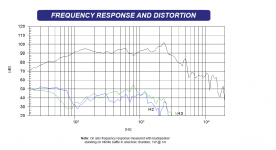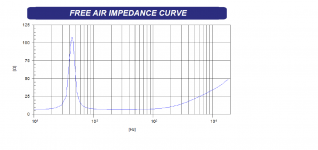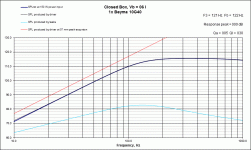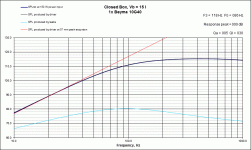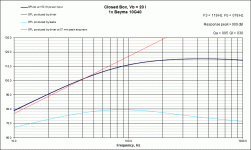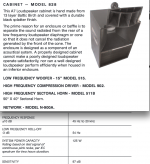if these are "raw" acourate measurements (i.e. you ran logsweep then have the initial Pulse.dbl shown) then this is an ungated in room response. I don't think you're going to draw too many useful conclusions from this from a speaker design point of view.What do you guys see?
if these are "raw" acourate measurements (i.e. you ran logsweep then have the initial Pulse.dbl shown) then this is an ungated in room response. I don't think you're going to draw too many useful conclusions from this from a speaker design point of view.
Indeed, the charts show what you described. What should I be doing?
BTW, regarding your earlier post around cutting/boosting with Acourate: I am under the understanding cutting through DSP is better than boosting to avoid clipping. Would you agree?
It shouldn't be too hard to measure down to to 200Hz in a typical room. Below this, the speaker response is eaiser to predict and can even be interpolated from nearfield measurements, and doesn't even matter that much due to the rooms influence. If you are trying to measure the baffle influence you probably only want to know where the slope is and what it looks like above this.
Actually, what I'm trying to measure is the influence of enclosure volume. The baffle size stays always the same (for now), as does the driver position within the baffle and relative to the floor.
My rationale is settling on an enclosure volume, decide 1 or 2 drivers per side, define baffle size, experiment with internal enclosure shapes, bracing.
How do I know what the greatest gating distance is? It turns out I was measuring ungated...might need to reprocess the data or even measure again. TBD.I'd try to find the greatest attainable gating distance in your room and measure down to that frequency, then find an alternative for measuring below that.
It seems few people perform micro-equalisation correctly, or even consider it. I think this has to account for some of the hype where they choose drivers that have a naturally clean response. Sometimes a naturally clean response is a sign of a good driver but not always.
Would you mind elaborating what you mean by micro-equalisation? Would DSP to achieve linearized driver response and room response be micro-equalisation?
I ask because Acourate software is a cornerstone in my system concept and does that, and I am yet to define which midrange to use and I value higher sensitivity as I would love to use a 45 or 2A3 SET on the 102dB TPLs and midranges. A horn midrange has some appeal along those lines.
Lewinski, I see the graphs you posted measuring what appears to be floor reflections.
You really should either (a) gate the measurement, which will still require you to get the microphone up from the floor, else your gate length will be super short, or (2) put the microphone right on the floor laying flat and facing the speaker.
OK, the second sounds odd, but it does work and can get good measurements avoiding all those nasty reflections.
To see the low frequency end, you will need to close mic the speaker, get the mic right in close to the cone and do a measurement - though I must say that at low frequencies the speaker modelling software is pretty accurate provided you have measured the driver well.
On your comments on two drivers, I still don't get your rationale for two per side. Provided there is a sub, and it crosses over to these at a sensible frequency, the excursions you speak of will only occur at very high SPL's. If it is just "because" then I get that -but that is not a rationale .
.
You really should either (a) gate the measurement, which will still require you to get the microphone up from the floor, else your gate length will be super short, or (2) put the microphone right on the floor laying flat and facing the speaker.
OK, the second sounds odd, but it does work and can get good measurements avoiding all those nasty reflections.
To see the low frequency end, you will need to close mic the speaker, get the mic right in close to the cone and do a measurement - though I must say that at low frequencies the speaker modelling software is pretty accurate provided you have measured the driver well.
On your comments on two drivers, I still don't get your rationale for two per side. Provided there is a sub, and it crosses over to these at a sensible frequency, the excursions you speak of will only occur at very high SPL's. If it is just "because" then I get that -but that is not a rationale
splicing a nearfield measurement (for the LF response) with a gated farfield measurement (for the HF response) would give you a cleaner view on what is going on. If you've measured the TS params of the drivers and have an accurate box model then that can be good enough for the LF part. You can cheat a bit with the gated measurement by using frequency dependent windowing, in particular this can help extend the LF extension of the gated measurement.Indeed, the charts show what you described. What should I be doing?
FWIW I find doing a traditional gated measurement in acourate to be a bit complicated as the UI for it is somewhat confusing, easier to use rew or holm for that tbh. I asked how they work earlier in the year, Uli replied on how those controls work in https://groups.yahoo.com/neo/groups/acourate/conversations/messages/7100
you just have to make sure you don't clip (go beyond 0dBFS) overall, if your filter does boost then that means you'd have to attenuate before the filter is applied. This could be fixed using some DSP chain or it could just mean you put a limit on your digital volume control. Remember that boost is a relative term as well, cutting some frequencies more than others is effectively a boost.BTW, regarding your earlier post around cutting/boosting with Acourate: I am under the understanding cutting through DSP is better than boosting to avoid clipping. Would you agree?
Last edited:
Avoiding room influence when measuring can include measuring the driver up close, the limitation to a nearfield measurement is that it becomes unreliable when the source should be becoming directional. Around resonance this probably won't be a problem. Another thing you can do is assess the impedance to see what the resonance is doing. Either way, since the low end will be under the influence of the room, the woofer resonance is not of too great an importance.Actually, what I'm trying to measure is the influence of enclosure volume.
If I've inadvertently led you astray with this, I apolgise.
The point I was making is that drivers that are equalised may sound the same, especially where their directivity is also the same. Obviously this normally amounts to a couple of dB here and there.Would you mind elaborating what you mean by micro-equalisation?
I assume at some point you'll be finding your own levels to equalise. If the TPL sounds about right to begin with, you'll find things much easier. Although it doesn't prove anything I typically have the greatest issues around the 3kHz region.
Some EQ issues (ie that are touchy and don't seem logical) can be the result of a crossover problem, including a poor matching of drivers/enclosures.
I just finished adding 10" midbass enclosures to my onkens, and my box volumes were WAY smaller than yours. Mid bass boxes are typically very small (like 1/2 cubic foot) to maintain driver loading and transient response (stiff cone returning back quickly). I tried no fill and it was boomy and all over the place freq response wise. I then stuffed a down pillow in the box and it killed it too much. A balance was achieved with light medium downe. The end result was simply amazing lower mids, and mates well with the 15" woofer at 500hz up to 1200hz for the midrange horn.




Try to reduce reflections as much as possible. Laying a big pile of fluffy, sound absorbent pillows, batting, quilts or whatever you have on the floor between the driver and the mic will help kill some of the floor reflections (props to Lynn Olsen for that tip). I use a half dozen bed pillows. Pull the speaker well into the room, and move any reflective objects (chairs, coffee table) away or out of the room if possible.
And do read the white paper I linked earlier. Combining near and far field measurements will help give a better picture of what's going on.
Bill
And do read the white paper I linked earlier. Combining near and far field measurements will help give a better picture of what's going on.
Bill
nice !
An excellent solution for a very widespread, but unaddressed problem !!
I just finished adding 10" midbass enclosures to my onkens, and my box volumes were WAY smaller than yours. Mid bass boxes are typically very small (like 1/2 cubic foot) to maintain driver loading and transient response (stiff cone returning back quickly). I tried no fill and it was boomy and all over the place freq response wise. I then stuffed a down pillow in the box and it killed it too much. A balance was achieved with light medium downe. The end result was simply amazing lower mids, and mates well with the 15" woofer at 500hz up to 1200hz for the midrange horn.


An excellent solution for a very widespread, but unaddressed problem !!
Is the OP using a gated response? That curve looks like combing effect from 2 woofers with near field mic, and too big a box.
Thanks for chiming in!
It was pointed to me the method I'm using with Acourate is un-gated. I need to install REW and redo these. Installation failed last night. Will try again tonite.
FWIW, though, the responses you see are from the lower driver only. The upper driver was placed there just to induce the baffle effects.
Your midbass runs from 500 to 1200 Hz. Mine is intended for 70/80 to 350/500 Hz. How would that affect enclosure volume, if anything? Thanks for including the picture. Nice project!
I'm not that fimiliar with your driver, and I'm sure others will correct me if I'm wrong, but...
From those freq ranges your dealing with a "rising response". There will be a natural roll off of the driver that the goal of the box is to simply offset that slope by loading or boosting the bass response in the lower frequencies.
I personally would look at the manufacturers freq plots, and then use WinISD to design either a sealed or ported small box that offsets the drivers natural rising response. A small sealed box will create a peak, then gently roll off. I would position that 'peak' a few hundred hz after the roll off, to flatten. If that doesn't work, maybe look at HornResp to design a mid front horn.
An Altec A7 type horn does exactly that in addressing a rising response in 80-500hz range, if you have the room of course. (But you gain like 10db in efficiency, and you don't need the massive back enclosure as you're running subs.
From those freq ranges your dealing with a "rising response". There will be a natural roll off of the driver that the goal of the box is to simply offset that slope by loading or boosting the bass response in the lower frequencies.
I personally would look at the manufacturers freq plots, and then use WinISD to design either a sealed or ported small box that offsets the drivers natural rising response. A small sealed box will create a peak, then gently roll off. I would position that 'peak' a few hundred hz after the roll off, to flatten. If that doesn't work, maybe look at HornResp to design a mid front horn.
An Altec A7 type horn does exactly that in addressing a rising response in 80-500hz range, if you have the room of course. (But you gain like 10db in efficiency, and you don't need the massive back enclosure as you're running subs.
I'm not that fimiliar with your driver, and I'm sure others will correct me if I'm wrong, but...
From those freq ranges your dealing with a "rising response". There will be a natural roll off of the driver..."
Not sure I'm fully tracking you here, but let's take a shot.
Attached are the frequency and impedance plots from the manufacturer. The rising you mention is the one up to 150Hz or thereabouts, right?
I know I want to build a sealed box, and I'm using UniBox, which is similar to WinISD I believe. Atttached are three plots of a single driver in a sealed box, heavy filling, driven at 150W even though I highly doubt I'll ever go that high."...that the goal of the box is to simply offset that slope by loading or boosting the bass response in the lower frequencies.
I personally would look at the manufacturers freq plots, and then use WinISD to design either a sealed or ported small box that offsets the drivers natural rising response. A small sealed box will create a peak, then gently roll off. I would position that 'peak' a few hundred hz after the roll off, to flatten. If that doesn't work, maybe look at HornResp to design a mid front horn.
6.3 liter box has Qtc of 0.709 and Fb of 122 Hz
15 liter box has Qtc of 0.53 and Fb of 86 Hz
20 liter box has Qtc of 0.49 and Fb of 78 Hz
What is the peak generated by the box you are referring to? The max SPL rolls in and off very gently.
I was thinking a larger box, such as the 20 liter, generates higher SPL at lower frequency (e.g. 70Hz) at a given power (150W). Since I'll use DSP to trim response, my idea was to start at 70Hz and make the response flat from there at the SPL achieved at 70Hz. I can do that with whatever size box, but I guess I was maximizing SPL at a given power usage. What you are saying is it will sound better with a smaller box with Qtc closer to 0.707, right?
I'll look into it. A quick Google search returns what seems to be a a horn enclosure with a vented box. I want to stay within sealed, but will look into the 80-500Hz horn. Any particular sources you consider better?An Altec A7 type horn does exactly that in addressing a rising response in 80-500hz range, if you have the room of course. (But you gain like 10db in efficiency, and you don't need the massive back enclosure as you're running subs.
Attachments
Oh okay. I see. I thought it was a more of a mid driver like my RCF L10-750, which has a lower Qts and 100db effieciency vs the Beyma, which is 95 and more "woofer". So it doesn't exhibit the rising response I was mentioning. I would start with the recommended ported enclosure of 1.5 cuft, with/without port, and go from there.


Oh okay. I see. I thought it was a more of a mid driver like my RCF L10-750, which has a lower Qts and 100db effieciency vs the Beyma, which is 95 and more "woofer". So it doesn't exhibit the rising response I was mentioning. I would start with the recommended ported enclosure of 1.5 cuft, with/without port, and go from there.
Interesting: 1.5 cu.ft equals 42.5 liters, which is pretty close to the 40 liters I started with.
Of course USSpeaker suggests a ported 1.5 cu.ft enclosure vs. mine that is sealed.
What next?
The model 828 A7 cabinet was only rated as 97 dB 1 watt one meter.A small sealed box will create a peak, then gently roll off. I would position that 'peak' a few hundred hz after the roll off, to flatten. If that doesn't work, maybe look at HornResp to design a mid front horn.
An Altec A7 type horn does exactly that in addressing a rising response in 80-500hz range, if you have the room of course. (But you gain like 10db in efficiency, and you don't need the massive back enclosure as you're running subs.
The small A7 mid-bass horn gives roughly a 3 dB boost in the 200-600 range, the huge box and high bass reflex tuning fills in the bass in 60-80 Hz range, but still results in a "stepped" response, the mid higher than the bass.
Attachments
Lewinski, I see the graphs you posted measuring what appears to be floor reflections.
You really should either (a) gate the measurement, which will still require you to get the microphone up from the floor,
I installed REW. What gate length should I be using? Left Side, Right Side? Is the default "Tukey 0.25" appropriate?
In terms of setup, is this ok?
- Pull the enclosures to the middle of the room.
- Have the bottom one sitting 2" above floor (like I intend to use them) and the top enclosure sitting atop to reproduce how the baffle would behave
- Place the mic at ear-level
- How far away should I place the mic from the drivers?
Testing the box ?
You know, I have had a chance to think about this:
If you are checking frequency response in a simple unfilled/unstuffed box
(with thin walls?) then you are simply checking what the box does.
In my view, you are better off checking the response from an installation that is much, much closer to what your final application will be.
I.E. sealed, in 1/2 a cubic foot, filled with acoustic absorbent of your choice.
I recommend unfaced pink panther.
You know, I have had a chance to think about this:
If you are checking frequency response in a simple unfilled/unstuffed box
(with thin walls?) then you are simply checking what the box does.
In my view, you are better off checking the response from an installation that is much, much closer to what your final application will be.
I.E. sealed, in 1/2 a cubic foot, filled with acoustic absorbent of your choice.
I recommend unfaced pink panther.
- Status
- This old topic is closed. If you want to reopen this topic, contact a moderator using the "Report Post" button.
- Home
- Loudspeakers
- Multi-Way
- Midbass section design with Beyma 10G40
